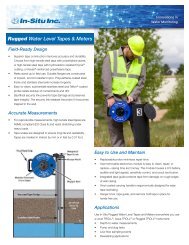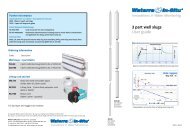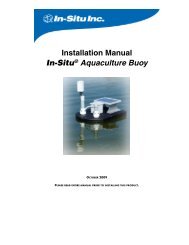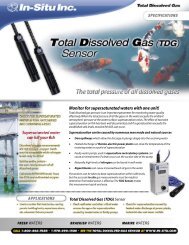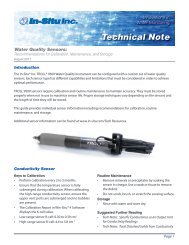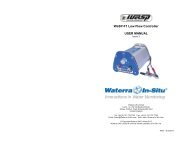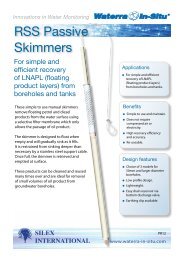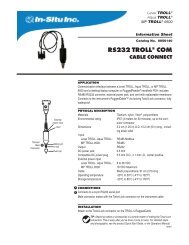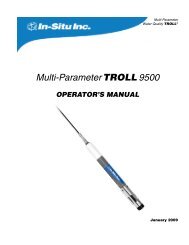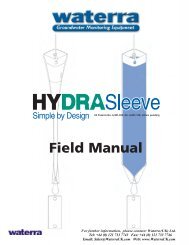Kansas Bureau of Waste Management 2006 ... - Waterra-In-Situ
Kansas Bureau of Waste Management 2006 ... - Waterra-In-Situ
Kansas Bureau of Waste Management 2006 ... - Waterra-In-Situ
Create successful ePaper yourself
Turn your PDF publications into a flip-book with our unique Google optimized e-Paper software.
HydraSleeve® SAMPLING STUDY<br />
AT<br />
KANSAS SMAL ARID LANDFILLS (SALs)<br />
by<br />
Stephanie J. Schauer, ESII<br />
Hydrogeologic Unit<br />
<strong>Kansas</strong> Department <strong>of</strong> Health and Environment<br />
<strong>Bureau</strong> <strong>of</strong> <strong>Waste</strong> <strong>Management</strong><br />
Solid <strong>Waste</strong> Permits Section<br />
1000 SW Jackson, Suite 320<br />
Topeka, <strong>Kansas</strong> 66612-1367<br />
October <strong>2006</strong><br />
DIVISION OF ENVIRONMENT ◊ <strong>Bureau</strong> <strong>of</strong> <strong>Waste</strong> <strong>Management</strong><br />
CURTIS STATE OFFICE BUILDING, 1000 SW JACKSON ST., STE. 320, TOPEKA, KS 66612-1367<br />
Voice 785-296-1600 Fax 785-296-1592 http://www.kdheks.gov/waste
HydraSleeve® Sampling Study<br />
at<br />
<strong>Kansas</strong> Small Arid Landfills (SALs)<br />
1.0 Objective: The objective <strong>of</strong> this study was to test an alternative sampling technique, the<br />
HydraSleeve® Sampler, at select Small Arid Landfills (SALs) in order to support general<br />
approval for use during regular ground water monitoring events. This new method <strong>of</strong> sampling<br />
has been shown to be a more cost effective method <strong>of</strong> sampling especially in areas where there is<br />
limited water available for sampling, as is the case at many <strong>of</strong> the SALs. Though much data is<br />
available though several other studies conducted by the EPA, ITRC, and the Army Corps <strong>of</strong><br />
Engineers, KDHE-BWM proposed to conduct a limited test study at current facilities prior to<br />
making the alternative sampling method available to any <strong>of</strong> the 33 SALs as an optional sampling<br />
method for ongoing site monitoring.<br />
2.0 Study Procedure: Split sampling using the HydraSleeve® was conducted at three<br />
facilities. The original proposal included sampling at four facilities. The fourth facility,<br />
Sheridan County, was eliminated from the study due to scheduling and time constraints.<br />
Samples were collected from Thomas County SAL on April 26, <strong>2006</strong>, Pratt County SAL on May<br />
2, <strong>2006</strong>, and Rooks County SAL on May 3, <strong>2006</strong>. Sampling was scheduled to coincide with<br />
regularly scheduled ground water monitoring events. All wells were inspected and static and<br />
total depth measurements were taken using an electric water level tape indicator prior to<br />
sampling. Samples collected using the HydraSleeve® were collected first. Immediately<br />
following collection <strong>of</strong> the HydraSleeve® sample, the wells were purged and sampled in<br />
accordance with current Sampling and Analysis Plans (SAPs) for respective facilities. Common<br />
purging and sampling procedure is to purge the well <strong>of</strong> a minimum <strong>of</strong> three borehole volumes<br />
using either a bailer or peristaltic pump. The samples are then collected using disposable or<br />
dedicated bailers.<br />
HydraSleeve® samples were collected in accordance with the standard operating procedures<br />
outlined in the “HydraSleeve Field Manual”. Appropriate sampling protective equipment was<br />
used at all times. Sampling gloves were changed between collection <strong>of</strong> each sample. Used<br />
HydraSleeves®, gloves, and sampling twine were disposed <strong>of</strong> as municipal solid waste. The<br />
non-dedicated, non-disposable sampler weights were decontaminated using an alconox wash and<br />
rinsed with distilled water between each sampling location. Samples were collected into<br />
laboratory-supplied containers, labeled, and immediately placed on ice. Samples were hand<br />
delivered to the <strong>Kansas</strong> Department <strong>of</strong> Health and Environment Laboratory (KDHEL) using<br />
proper chain <strong>of</strong> custody procedures. All field forms, chain <strong>of</strong> custodies, laboratory analytical<br />
reports, site maps, and the “HydraSleeve Field Manual” are attached as appendices.<br />
HydraSleeve® Study<br />
October 1, <strong>2006</strong><br />
Page 2
2.1 Sample Analysis: Samples collected by KDHE with the HydraSleeve® were submitted to<br />
KDHEL for analysis <strong>of</strong> Volatile Organic Compounds (VOCs) and Metals by EPA methods 8260<br />
and 200.7, respectively. All samples were analyzed within holding times. All Laboratory<br />
reports are attached as appendices. While a full list <strong>of</strong> 8260 and 200.7 constituents were<br />
analyzed by KDHE, SAL facilities are monitored for an abbreviated list <strong>of</strong> constituents as per<br />
K.A.R. 28-29-103(f). Those constituents and respective maximum contaminant levels (MCLs)<br />
are listed in the table below. For the purposes <strong>of</strong> this study, only these 14 constituents were used<br />
for comparative purposes.<br />
Monitoring Constiuents for SALs<br />
Table 1 - K.A.R. 28-29-103(f)<br />
VOCs<br />
MCL (mg/L) MCL (ug/L)<br />
Benzene 0.005 5<br />
1,2-Dichloroethane 0.005 5<br />
1,1-Dichloroethene 0.007 7<br />
1,2-Dichloropropane 0.005 5<br />
Ethylebenzene 0.7 700<br />
Styrene 0.1 100<br />
Tetrachloroethene (PCE) 0.005 5<br />
Toluene 1 1000<br />
1,1,1-Trichloroethane 0.2 200<br />
Trichloroethene (TCE) 0.005 5<br />
Vinyl Chloride 0.002 2<br />
Total Xylenes 10 10,000<br />
Metals<br />
Cadmium 0.005 5<br />
Chromium 0.1 100<br />
3.0 Study Results: A total <strong>of</strong> fifteen samples from three facilities were collected for<br />
comparison. An additional 16 th well was sampled at the Pratt County SAL using the<br />
HydraSleeve®; however, the well was purged dry and a sample was unable to be collected using<br />
the standard sampling method. Results from each <strong>of</strong> the facilities is presented and discussed<br />
individually below.<br />
3.1 Thomas County SAL: Samples were collected from five monitoring wells, MW-3, MW-4,<br />
MW-5, MW-7, and MW-8 on April 26, <strong>2006</strong>. MILCO Environmental Services, <strong>In</strong>c. (MILCO)<br />
was present to conduct the 1 st Semiannual Sampling event for <strong>2006</strong>. Monitoring wells MW-7<br />
and MW-8 were installed on April 13, <strong>2006</strong> as required under new expansion and were sampled<br />
for the first time during this event. All five wells were successfully sampled using both sampling<br />
techniques. Analytical results are presented in the table below.<br />
HydraSleeve® Study<br />
October 1, <strong>2006</strong><br />
Page 3
HydraSleeve Split Sampling Study Data<br />
Thomas County SAL Results<br />
HydraSleeve Samples<br />
Purge Samples<br />
VOCs (ug/L) MCL (ug/L) MW-3 MW-4 MW-5 MW-7 MW-8 MW-3 MW-4 MW-4Dup MW-5 MW-7 MW-8<br />
Vinyl Chloride 2
3.2 Pratt County SAL: Samples were collected from five monitoring wells, MW-1, MW-2A,<br />
MW-4, MW-5, and MW-6 on May 2, <strong>2006</strong>. Allied Environmental Consultants, <strong>In</strong>c. (AEC) was<br />
present to conduct the 1 st Semiannual Sampling event for <strong>2006</strong>. Pratt County SAL currently<br />
monitors 6 wells semi-annually. Monitoring well MW-3A contained only 0.75 ft <strong>of</strong> water. By<br />
placing a HydraSleeve® at the bottom <strong>of</strong> the well with a top weight, a half sampler volume was<br />
able to be collected. The well then purged dry and a sample was unable to be collected using<br />
traditional methods. The sample collected from the HydraSleeve® was not submitted for<br />
analysis due to the lack <strong>of</strong> comparability at that location. While sufficient water was available to<br />
fill the required containers for the KDHEL, it may not have resulted in enough water to meet<br />
other laboratory’s required volumes without special arrangements. Pratt County SAL has<br />
recently amended the list <strong>of</strong> parameters to be monitored at the request <strong>of</strong> KDHE. For the<br />
purposes <strong>of</strong> this study, arsenic results were also used for comparative analysis since there were<br />
detections during this event. Analytical results are presented in the table below.<br />
HydraSleeve Split Sampling Study Data<br />
Pratt County SAL Results<br />
HydraSleeve Samples<br />
Purge Samples<br />
VOCs (ug/L) MCL (ug/L) MW-1 MW-2A MW-4 MW-5 MW-6 MW-1 MW-2A MW-4 MW-5 MW-6<br />
Vinyl Chloride 2
samples. Historically, these metals have been detected at this facility at comparable levels.<br />
Historical data shows trends <strong>of</strong> decreasing metals levels; however, the low level detections<br />
appear to be persistent. <strong>In</strong> comparing the data from this event, the low level detections appear to<br />
be similar. It should also be noted that detections are only slightly above laboratory detection<br />
limits and that the detection limits <strong>of</strong> the two laboratories vary slightly. The HydraSleeve®<br />
sampler provides a method <strong>of</strong> sampling that results in less agitation <strong>of</strong> water in the well, and thus<br />
stirs up less sediment resulting in less turbid samples. Elevated or erroneous metals levels can<br />
easily be attributed to suspended solids in ground water samples. While turbidity readings were<br />
not collected for the HydraSleeve® samples, visual observation <strong>of</strong> samples notes much clearer<br />
samples from the HydraSleeve®, prior to purging and bailing.<br />
3.3 Rooks County SAL: Samples were collected from four monitoring wells, MW-11, MW-12,<br />
MW-13, and MW-14 on May 3, <strong>2006</strong>. Rooks County is currently approved to conduct their own<br />
sampling events in lieu <strong>of</strong> obtaining the services <strong>of</strong> a consultant. Rooks County staff members<br />
responsible for the landfill monitoring were present to conduct the 1 st Semiannual Sampling<br />
event for <strong>2006</strong>. Analytical results are presented in the table below.<br />
HydraSleeve Split Sampling Study Data<br />
Rooks County SAL Results<br />
HydraSleeve Samples<br />
Purge Samples<br />
VOCs MCL (ug/L) MW-11 MW-12 MW-13 MW-14 MW-11 MW-12 MW-13 MW-14<br />
Vinyl Chloride 2 0.7
4.0 Conclusions: Based on the observations and results <strong>of</strong> this limited test study it appears that<br />
the HydraSleeve® sampling method would serve as a supplemental alternative sampling at the<br />
Small Arid Landfill facilities, as well as other facilities throughout the state <strong>of</strong> <strong>Kansas</strong>. While<br />
this limited study may not provide sufficient data for accurate statistical analysis, side-by-side<br />
comparison <strong>of</strong> data collected as well as comparison with historical data and trends suggests that<br />
using the HydraSleeve® for ground water monitoring can provide consistent results with current<br />
traditional methods. While providing consistent and accurate data, the HydraSleeve® also<br />
provides several added benefits for both KDHE and the regulated facilities.<br />
The side-by-side data comparison does not result in exactly replicated data; however the<br />
differences support many <strong>of</strong> the suggested advantages <strong>of</strong> using the HydraSleeve® over<br />
traditional purge and bail methods. The HydraSleeve® method <strong>of</strong> sampling is intended to<br />
reduce the agitation <strong>of</strong> well water during sampling to prevent volatilizing <strong>of</strong> constituents and<br />
disturbance <strong>of</strong> fine sediments within the well that can cause erroneously elevated metals levels.<br />
The HydraSleeve® sampler is also designed to be a closed sampling devise to eliminate potential<br />
for additional <strong>of</strong>f-gassing <strong>of</strong> VOCs when brought into contact with the air or cross contamination<br />
when handling the sample while transferring to sample containers. These benefits would result<br />
in more frequent low-level detections <strong>of</strong> VOCs in samples, where these lower levels may be<br />
volatilized out using traditional methods. This may provide an additional benefit to both the<br />
facilities and KDHE when monitoring around unlined landfills. Detecting potential impacts at a<br />
lower level, sooner, may provide much needed time to implement corrective measures before the<br />
levels reach those that would result in the loss <strong>of</strong> permit exemption as a SAL.<br />
The same reduction in well disturbance and sample agitation also results in less turbid samples.<br />
As is shown by the history <strong>of</strong> many SALs, elevated metals level detections have been a common<br />
occurrence. When a constituent <strong>of</strong> concern is detected at a significant level or above a MCL, it is<br />
stated in regulation that KDHE be notified within 14 days and a confirmation sampling event<br />
conducted within 30 days <strong>of</strong> the original sampling date (K.A.R 28-29-103(f)(6)). <strong>In</strong> the case <strong>of</strong><br />
elevated metals detection, KDHE has historically accompanied the facility representative<br />
sampler during the confirmation sampling to collect a split sample. The KDHE split sample<br />
consists <strong>of</strong> a standard collection method sample and one that is field filtered and then submitted<br />
to KDHEL for metals analysis. The facility sample is collected and submitted using standard<br />
collection methods (unfiltered). Should the standard collection method sample analysis show<br />
consistent findings <strong>of</strong> the original sampling event, and the filtered sample show a significant<br />
reduction in metals levels, the original data is assumed to be erroneously elevated due to<br />
sediment/matrix interference. This facility is then monitored for spikes in metals elevations and<br />
the data collected from the confirmation event is considered background data upon which to<br />
compare future results. Often times this process can result in multiple confirmation events at an<br />
extra expense to both the facility and KDHE. If samples were able to be collected initially with a<br />
method that eliminates much <strong>of</strong> this sediment/matrix interference, there would be a significant<br />
reduction in these unnecessary events. Metals analysis would be more accurate and<br />
representative <strong>of</strong> actual conditions at the facility.<br />
Additionally, the HydraSleeve® method allows for sampling <strong>of</strong> wells containing significantly<br />
less water. As chronic drought conditions continue across the state, and water levels continue to<br />
HydraSleeve® Study<br />
October 1, <strong>2006</strong><br />
Page 7
decrease in many monitoring wells, this becomes a very important benefit for both KDHE and<br />
the regulated facilities. This can prolong the life <strong>of</strong> existing wells allowing for much needed<br />
time for the counties to plan and budget for new wells while still collecting consistent and<br />
representative data for monitoring.<br />
Lastly, the added benefit <strong>of</strong> time reduction and ease <strong>of</strong> collection using the HydraSleeve® can<br />
simplify the monitoring process for many facilities. Sample collection using the HydraSleeve®<br />
on average has been shown to take an average <strong>of</strong> 15 minutes per well. Purging and bailing a well<br />
by hand to collect a sample can take considerably longer. Also, at many <strong>of</strong> the SALs, the wells<br />
will purge dry and it is standard practice to revisit the well the next morning to collect a sample<br />
once the well has recharged. Facilities that have retained a consultant to conduct sampling will<br />
save money as the consultant saves time and money as less consultant hours are spent in the field<br />
collecting data. Less equipment would be required for the sampling process and therefore <strong>of</strong>ten<br />
less staff. <strong>In</strong> the case <strong>of</strong> facilities that conduct their own sampling (i.e. Rooks County SAL), the<br />
ease <strong>of</strong> use with this method allows for easier training <strong>of</strong> personnel, reduction <strong>of</strong> time spent away<br />
from regular duties, less need for bulky or expensive equipment (i.e. pumps if needed), and<br />
eliminate the potential for error in the sampling process. <strong>In</strong> many cases with this sampling<br />
method provided as an option, many additional SAL facilities might be able to opt to conduct<br />
their own sampling events while retaining the services <strong>of</strong> a consultant to write the final report.<br />
5.0 Recommendation: Based on the findings <strong>of</strong> this limited study and much research, it is my<br />
opinion that the use <strong>of</strong> the HydraSleeve® for ground water monitoring be approved. While<br />
providing consistent and accurate data, this method also allows facilities to take advantage <strong>of</strong><br />
many benefits should they chose to select this alternative method <strong>of</strong> sampling. Guidance should<br />
be provided to the facilities and their consultants on the availability <strong>of</strong> the optional sampling<br />
method and how to obtain individual approval and make the appropriate amendments to their<br />
Sampling and Analysis Plans (SAP). This may include formulation <strong>of</strong> a Technical Guidance<br />
Document outlining the request process. Facilities should provide written request to select the<br />
new sampling method, and this request, upon approval, can be included in current SAPs as<br />
addendum to eliminate the need for full resubmittal <strong>of</strong> the SAP. <strong>In</strong> order to document the<br />
sampling procedure the “HydraSleeve® Field Manual” could be included as attachment.<br />
Should facilities opt to begin conducting their own sampling, proper guidance should be given to<br />
train the facility personnel responsible for sampling. This could be accomplished by having a<br />
KDHE representative present during the first sampling event for training purposes.<br />
Alternatively, a KDHE representative could be present at a facility that wishes to host a training<br />
session for multiple counties located nearby.<br />
HydraSleeve® Study<br />
October 1, <strong>2006</strong><br />
Page 8
Additional information regarding obtaining and use <strong>of</strong> the HydraSleeve® can be found at:<br />
www.hydrasleeve.com or www.geoinsightonline.com. Or by contacting:<br />
6.0 References:<br />
Kent Cordry<br />
Geo<strong>In</strong>sight<br />
1680 Hickory Loop, Suite B<br />
Las Cruces, NM 88005<br />
(800) 996-2225<br />
(505) 523-5799<br />
(505 523-0789 (fax)<br />
geoinsightonline@yahoo.com<br />
Allied Environmental Consultants, <strong>In</strong>c., Don A. Breit, P.G. May 18, <strong>2006</strong>. “Semi-Annual<br />
Monitoring Report, Pratt County Landfill Sampling Event – Spring <strong>2006</strong>”.<br />
<strong>In</strong>terstate Technology & Regulatory Council. March <strong>2006</strong>. “Technology Overview <strong>of</strong> Passie<br />
Sampler Technologies.<br />
MILCO Environmental Services, <strong>In</strong>c., Leah MacNeill. June 14, <strong>2006</strong>. “Semi-Annual Sampling<br />
Results, April <strong>2006</strong>, Thomas County Landfill”.<br />
PARSONS. October 2005. “Final – Results Report for the Demonstration <strong>of</strong> No-Purge<br />
Groundwater Sampling Devices at Former CcClellan Air Force Base, California”.<br />
Rooks County Landfill, Rich E. Bouchey. June 5, <strong>2006</strong>. “Groundwater Sampling and Analysis<br />
May Event, Rooks County Landfill, Rooks Co. Ks”.<br />
www.hydrasleeve.com<br />
HydraSleeve® Study<br />
October 1, <strong>2006</strong><br />
Page 9



